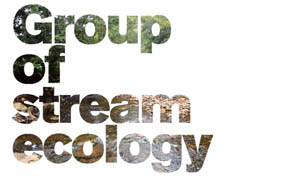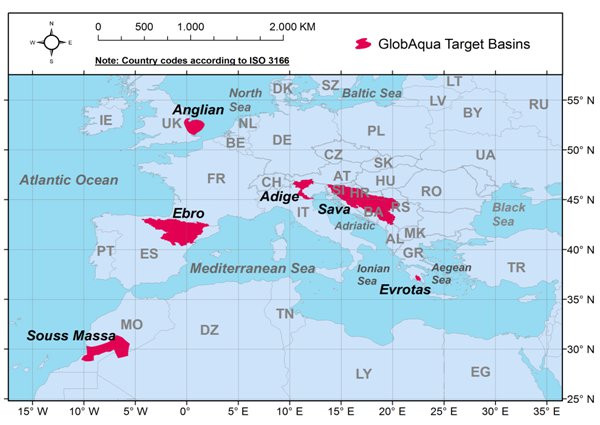
 |
Previous projects |
|
IBERAQUA-NET.
Scientific network addressing the effects of water scarcity
in Iberian rivers: Recommendations for management IBERAQUA-NET is a multi-disciplinary network that focuses
on the effects of water shortage in Iberian rivers, and aims
to provide a series of scientific recommendations to improve
the management of fluvial ecosystems. This multi-disciplinary
network includes researchers with recognized experience in
analytical chemistry (CSIC-IDAEA, UVEG, CSIC-ICMAN), ecology
(ICRA, UB, CSIC-ICMAN, EHU, IMDEA, UdL), modeling and numerical
techniques (URV, ICRA), and water management (ICRA, IMDEA).
The network will act as a unique platform to consolidate the
ongoing research efforts and transfer knowledge to different
sectors, either directly or indirectly related to water. The
External Advisory Committee consists of both experienced
researchers from the EU and water managers from agencies and
hydrographic confederations, offering an integrated point of
view. IBERAQUA-NET aims to translate the basic knowledge
generated by various projects into recommendations for river
management and uses strategic methods to disseminate and transfer
knowledge in order to ensure that the results of research reach
the target audience. The main tool will be the preparation and
dissemination of the document “Recommendations for Management”. |
|
BioLoss: Functional consequences
of biodiversity loss caused by emerging diseases in
freshwater ecosystems The current rates of biodiversity loss are alarming and
caused by different anthropogenic factors. Freshwater
ecosystems are among the most affected on Earth.
The loss of biodiversity is of concern due to its intrinsic
value, but also because it can affect the functioning of
ecosystems and the services and resources they provide
to humans (e.g., good-quality water). The expansion of
emerging diseases is a main factor associated to global
change (intensified by climate change), which is producing
massive extinctions of different organisms that are
fundamental for freshwater ecosystems. In this project we
examine how species loss in two groups of such organisms
(riparian plants and amphibians) alters the functioning of
headwater streams and mountain wetlands, respectively.
We establish future scenarios of species loss caused by
the expansion of pathogenic fungi of the genera Phytophthora
and Batrachoquitrium. Using different experimental approaches
we test several hypotheses about changes in ecological processes
which are key for the provision of ecosystem services and the
use of water resources. Our objectives thus fit the fifth
Challenge of society, which is part of the Spanish State
Plan for Scientific and Technical Research and Innovation,
and focuses on action against climate change and efficiency
in resource use. |
|
PURIFY Effects of desiccation on the self-purification capacity
of headwater streams: Consequences for the stream
management. Reference: KR17AC0K13643, Climate and Energy
Fund, Austrian Government. |
|
DESEMBALSE In the last decades dam removal has gained momentum as a
tool for river restoration, although still little is known
on its impacts and benefits on river ecosystems. The
Enobieta Reservoir (Artikutza, Navarre, 42 m tall), built
in the 1950´s, to supply drinking water to the province of
Gipuzkoa, has been unmanaged since the Añarbe Reservoir
was built further downstream in 1976. Structural problems,
aggravated by decades of neglect, prompted the
municipality of Donostia – San Sebastian to decomission
the dam (the largest so far removed in Europe) by digging
a tunnel through it. Project DESEMBALSE will investigate
the effects of this major work on sediment dynamics, river
biological communities and ecosystem functioning following
a before-after control-impact (BACI) design. The main
hypothesis is that the emptying of the reservoir will
produce geomorphological changes both upstream and
downstream from the dam, which will both affect both
riverine communities and ecosystem functioning. Upstream
from the dam a lotic habitat will be recovered whereas
downstream sediment transport will cause channel
agradation with significant changes in hydraulics. Given
the high dynamism of the rivers in the area, a rapid
recovery is expected as the sediments are distributed
towards down. The results obtained from this study will
provide comprehensive information on the interaction
between biological and geomorphological effects after
emptying the reservoir. |
|
DIVERSION: Multi-scale
consequences of water diversion on river ecosystems. Water diversion is a prevalent activity in streams and
rivers, and is likely to intensify in the near future as a
result of the escalating demand for irrigation,
hydropower, and drinking water. The effects of large
reservoirs on river ecosystems are relatively well known,
but there are many questions regarding the impact of water
diversion by low weirs such as those commonly used in many
hydropower and irrigation schemes. Reduced discharge in
the bypassed river sections can affect water flow and
chemistry and promote siltation, and increase the relative
cover of dry versus wet riverbeds, thus affecting
biodiversity and ecosystem functioning, as well as the
ecosystem services we derive from rivers. Furthermore,
water diversion will likely interact with other stressors
such as pollution, aggravating their impacts. Project
DIVERSION aims at assessing the impacts at multiple scales
of water diversion by low weirs on the biodiversity and
ecosystem functioning of north Iberian rivers, as well as
the interaction between diversion and pollution, a
prevalent stressor in many rivers. It does so by combining
field and laboratory experiments and addressing different
components of the river ecosystems, from biofilm to fish,
as well as different processes linked to the
biogeochemical functioning of these ecosystems. It will
combine state-of-the-art techniques and take into account
both the wet and the dry parts of river channels. The
starting hypothesis is that diversion will deteriorate
stream habitats, what in turn will have negative effects
on organisms, eventually impacting river ecosystem
processes and affecting the biogeochemical functioning of
entire river networks. These impacts will be enhanced when
stream ecosystems are subject to other stressors such as
pollution or sediment deposition.
|
|
Invasion of stream ecosystems by the red swamp crayfish: mechanisms responsible for the invasion success and consequences at eco-evolutionary and socieconomic levels We will address two types of phenomena characterizing the invasion of streams by the red swamp crayfish (RSC): (1) the mechanisms responsible for its successful establishment in such a novel habitat (its original habitat being swamps and marshes) and (2) the ecological, evolutionary and socio-economic consequences of its invasion. We will address our first objective using new generation sequencing techniques (genomics and transcriptomics). We will compare the genome of stream and swamp populations and identify loci responsible for local adaptation. We will examine gene expression patterns in individuals subjected to environmental conditions (current, temperature, salinity) typical of either streams or swamps to identify mechanisms responsible for the successful invasion of the stream habitat. We will also compare the genetic diversity of invasive populations to those of the native range to identify patterns of introduction, spread and gene flow. We will explore the effects of the RSC on stream ecosystem structure and functioning (food web complexity, rates of key ecological processes) and on interactions with the native crayfish and native fish and amphibians (rates of predation, prey ability to recognize the predator through chemical cues, infection by crayfish plague and chytrid fungus). We will use an evolutionary perspective, comparing the ecological effects of stream RSC populations (which have potentially evolved in response to the new habitat) to those of founder, swamp populations. Finally, we will examine the socio-economic consequences of the RSC by quantifying its effects on several key ecosystem services (nutrient retention, litter decomposition) and modelling the economic cost of its spread through stream networks. This project was funded by the Junta de Andalucía,189,894 (2014-2017) |
|
This EU-FP7 project aims at identifying the prevalence,
interaction and linkages between stressors, and to assess
their effects in the chemical and ecological status of
water ecosystems in order to improve water management
practice and policies. It involves a multidisciplinary
team of 21 European partner organizations plus 2
non-European partners from Morocco and Canada, as well as
the active involvement of water authorities, river basin
managers, and other relevant stakeholders. A cross-scale
approach is applied in six representative basins: Ebro,
Adige, Sava, Evrotas, Anglian River and Souss Massa. The
main added value of GLOBAQUA project is the inclusion a
multidisciplinary team of leading scientists in the fields
of hydrology, chemistry, biology, ecology, geomorphology,
economics and sociology, including hydrological,
biophysical and ecological modelling, socio-economics and
governance science, knowledge brokerage and policy
advocacy, in order to study the interaction of multiple
stressors in freshwater ecosystems within the frame of
strong pressure on water resources. The project performs
data-mining and field- and laboratory-based research, as
well as modelling at different spatial scales and
socioeconomic research. The results will be placed under
the scope of societal and economical needs, with improved
policy implementation being the final product. GLOBAQUA
will develop a relevant Programme of Measures in order to
reduce the Science-Policy interface gap.  |
|
BIOFUNCTION.How will the
biodiversity crisis affect vital stream ecosystem
functions? We are facing biodiversity loss at unprecedented rates,
and there is unequivocal evidence that changes in
biodiversity can alter ecosystem functioning. However, our
mechanistic understanding of biodiversity effects on vital
functions such as plant litter decomposition and element
recycling (which are key components of the global carbon
cycle) is still in its infancy. This project addresses
some existing gaps in our understanding of how these
functions might be affected by biodiversity loss, using
forest streams as model systems. We examine several key
questions: 1) whether the functional diversity of plant
litter and detritivores has a greater influence on
decomposition than species richness; 2) whether more
diverse plant litter pools lead to more efficient
decomposition, explicitly taking into account the
different forms of carbon and nutrients into which litter
is converted; 3) whether top-down are greater than
bottom-up diversity effects on decomposition and element
recycling; and 4) whether the magnitude of diversity
effects on decomposition rivals the single and joint
impacts of key drivers of global environmental change. Our
experimental manipulations in microcosms will simulate
realistic diversity loss and environmental change events,
and the use of several techniques that are novel within a
biodiversity-ecosystem functioning context will facilitate
the investigation of the biological mechanisms ultimately
responsible for biodiversity effects on decomposition.. |
|
|
|
|
|
Assessing functional variability of small Iberian streams
|
|
Solutions to problems affecting river ecosystems will
arrive with a better understanding on their structure and
function. Leaf litter decomposition is a pivotal process
in the stream functioning, and sensitive to disturbances.
The aim of this project, founded by Spanish Ministry of
Education and Science, is to assess the impact of
different kind of disturbances (Nutrient enrichment, Flow
regulation & Catchment land uses) in the functioning
of low order Iberian streams through the response of leaf
litter decomposition, in four geographic and climatic
regions in the Iberian Peninsula. |
|
COMPLEXTREAM: Restoring channel complexity in Basque streams
|
|
TEMPERIOS: Effect of temperature on the functioning of streams in Northern Spain The project continues as RIOTEM . |
|
RIOTEM: Effect of temperature on
the functioning of streams in Northern Spain
|
|
|
|
|